Rosalie Meany loved throwing lavish, show-stopping parties for the highest of high society. For one Christmas party, she wore a custom gown decorated with twinkling tree lights. Another time, she hosted an exclusive performance by Metropolitan Opera singer Madame Alma Gluck for 200 guests in her impressive great hall.
Meany had the right house for such excesses. Her palace was a castle called Alnwick Hall, one of the many opulent estates that once lined Madison Avenue in Morristown, an area dubbed Millionaires’ Mile in its heyday.
Alnwick Hall was built in 1904 for Meany (born Rosalie Behr) and her well-connected husband, General Edward P. Meany, an attorney who served as the judge advocate general of New Jersey and director of the American Telephone and Telegraph Company (AT&T). The inspiration for Rosalie and Edward’s 32-room home was Alnwick Castle in Northumberland, England. The royal fortress dates to 1096; in modern times, it served as the set of Hogwarts in the first two Harry Potter films.
Alnwick Hall: The Abbey
Morristown
Vacant office space
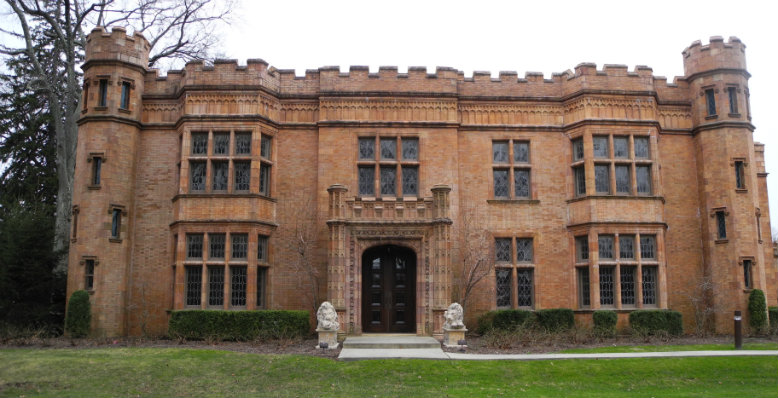
Alnwick Hall at 355 Madison Avenue in Morristown. Photo: Joanna Buffum
In Rosalie Meany’s day, Morristown was a colony for the super-rich. Sadly, only a handful of the estates built during the town’s Golden Years (1880-1929) remain. These castles and others around New Jersey are vestiges of the state’s Tudor Gothic revival, an early-20th-century architectural movement by the elite to emulate old-world money. The stone walls and turrets of these grandiose structures have concealed scandals, bankruptcies, accusations of black magic and all manner of tragedies—even an infamous murder-suicide attempt.
The castles still standing throughout New Jersey represent a fairy-tale lifestyle that was doomed to fade amid the economic and political turmoil of the 20th century. Many have taken on new lives far removed from their original intent. In Morristown, the Lindenwold mansion on South Street, built in 1888 for New York lawyer William Skidmore, was purchased in 1947 by the Peck School; it now houses the private school’s offices. In Paterson, Lambert Castle, built in 1892, was the domain of silk moguls Catholina and Isabella Lambert; today, it’s the Passaic County Historical Society’s museum and library. Kip’s Castle in Verona, a 30-room Norman-style mansion completed in 1905 for textile titan Frederic Ellsworth Kip and his wife, Charlotte Bishop Williams Kip, is now owned by the Essex County Park System.
As for Rosalie Meany’s grand estate, the years have not been kind. After Rosalie’s death, Edward remarried and sold the house in 1926. For a period, Alnwick Hall served as a Lutheran church. Later, it was partitioned into commercial offices and renamed the Abbey. In 2007, entrepreneur Tom Maoli purchased the building—right at the onset of the subprime mortgage crisis and the 2008 bankruptcy of Lehman Brothers. “All of the tenants started pulling out,” says Maoli. “The office market basically imploded.” The once-proud building has been on the market for four years. Asking price: $5.9 million.
The following provides a peek at some of New Jersey’s other remaining castles.
Glynallyn Castle
Convent Station
Private residence
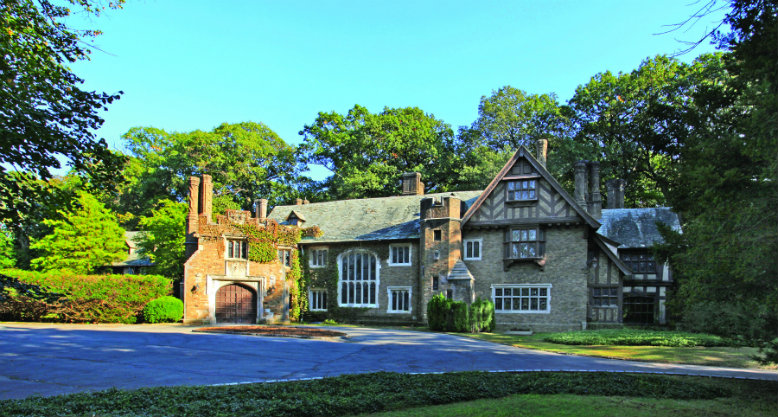
Glynallyn Castle as seen before its Mansion in May renovations in 2012. Photo courtesy of the Women’s Association of Morristown Medical Center
Just a short walk from Alnwick Hall stands another vestige of Morristown’s Golden Years. In 1912, entrepreneur and world traveler George Marshall Allen purchased 10 acres to build a home inspired by Compton Wynyates, a 16th-century castle in Warwickshire, England. Allen hired architect Charles I. Berg to replicate its design; the project was completed by 1917. Allen, who named his home for a glen behind the property, was a perfectionist and added superficial cracks and worn wood to convey age. During a serendipitous visit to Compton Wynyates, Allen was able to obtain discarded 400-year-old oak paneling and ship it back to New Jersey to be installed in his foyer. Glynallyn holds many secrets: the dining room has three fake wall panels (one hid Allen’s silver safe); pressing a floorboard in the Great Hall opens an oak panel, revealing a spiral stone staircase that leads down to the dungeon.
Allen died in 1941; his widow remarried in 1946. The castle served as world headquarters of General Drafting Company, a famed mapmaker, from 1952 to 1992. In 1996, Chris and Melitta Shields bought the majestic building for a mere $1.15 million. They made it their home, and it became a popular destination for trick-or-treaters until the Community Bank of Bergen County foreclosed on the property in 2011. In 2012, the vacant castle was restored to its former glory for Morris County’s biannual Mansion in May fundraiser. However, during Hurricane Sandy, a tree fell and broke a window, leaving the vacant home exposed to the elements for two years.
Glynallyn was sold again in 2014 to current owners Joseph and Catherine Cetrulo, the principals of Trinity Hospitality Group, which includes Sirena Ristorante in Long Branch and Cubacan and Stella Marina in Asbury Park. The couple was happily living nearby when Joseph discovered the vacant castle. The Cetrulos have since renovated the entire mansion, adding a commercial-grade kitchen and medieval furnishings from local antique shops. They plan to host wine tasting events in the dungeon and have hopes that a cooking show might be filmed in their not-so-humble abode.
Skylands Manor
Ringwood
New Jersey Botanical Garden
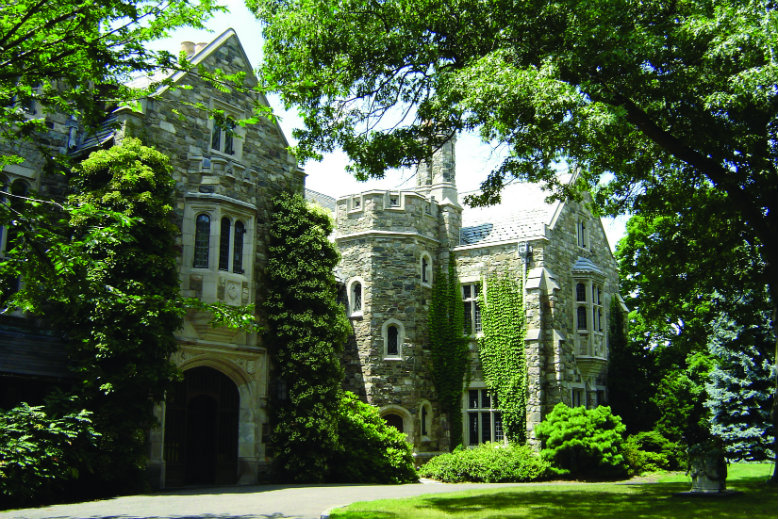
Skylands Manor at the New Jersey Botanical Garden. Photo courtesy of Maja Britton
In 1922, Jersey City-born horticulturalist Clarence McKenzie Lewis purchased land in the Ramapo Mountains. Lewis, who had studied in Germany and England, wanted to build a home worthy of Europe—with much influence from his mother, Helen Salomon, a wealthy widow who favored the Tudor style. To fulfill his vision, Lewis hired architect John Russell Pope, whose firm created several Washington, D.C., landmarks, such as the Jefferson Memorial.
Granite for the home was quarried on the property at Pierson Ridge in Bergen County. Italian marble lines the breakfast room, which features a three-tiered lavabo from a Renaissance-era palazzo in Venice. The drawing room is paneled in Scandinavian pine. Pope and New York stained-glass designers Heinegke & Smith imported 16th-century glass pieces from Europe to create leaded windows. Meanwhile, Lewis turned the grounds into a series of botanical gardens.
In 1953, Lewis sold all 1,117 manicured acres to the National Bible Institute. The state of New Jersey purchased the property in 1966. Two decades later, Governor Tom Kean designated the 96 acres around the manor as the official state garden. It’s now a popular wedding venue operated by Frungillo Caterers.
Blair Hall
Princeton University
Dormitory
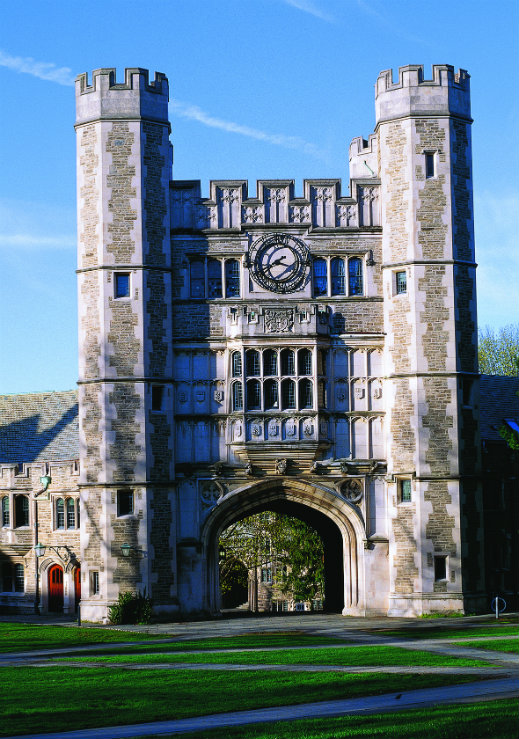
Blair Hall at Princeton. Photo courtesy of Walter Smalling, Jr.
Not all of New Jersey’s castles started as private residences. Blair Hall, with its four crenellated towers rising above a pointed archway, was erected as a Princeton University dormitory in 1898. It was the first campus building designed in the Collegiate Gothic style mandated two years earlier by the trustees. The goal was to reproduce the look and feel of England’s most prestigious institutions of higher learning. In an oft-quoted 1902 address to alumni, university president (and future U.S. president) Woodrow Wilson proudly stated:
“By the very simple device of building our new buildings in the Tudor Gothic style we seem to have added to Princeton the age of Oxford and Cambridge; we have added a thousand years to the history of Princeton by merely putting those lines in our buildings which point every man’s imagination to the historical traditions of learning in the English-speaking race.”
Today, a stroll around parts of the Ivy League campus is like stepping back in time to medieval England. There are so many gargoyles that the college has a 36-page directory affectionately known as the “Little Book of Gargoyles.” Dillon Gymnasium, completed in 1947 with an impressive crenellated entry tower, was one of Princeton’s last projects in the Collegiate Gothic style.
Iviswold Castle
Rutherford
Felician College Campus Center
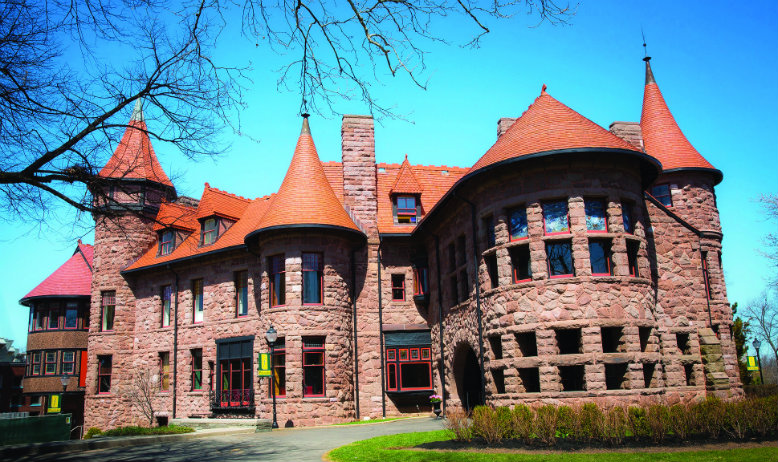
The Castle at Felician University at One Felician Way in Rutherford. Photo courtesy Felician University.
How Iviswold Castle became a sanctuary for higher education is a curious tale. Book publisher David B. Ivison bought a stone home on a Rutherford hilltop in 1887 and hired Ithaca, New York-based architect William H. Miller—who designed much of Cornell University—to expand it into a 25-room high-Victorian castle, complete with towers of brownstone quarried in Belleville. Ivison lived there until the stock market crash of 1901; a few owners later, coal tycoon Solomon Milton Schatzkin made several key additions, including an indoor pool on the second floor. But by the Great Depression, Rutherford National Bank had seized the property.
The vacant castle seemed doomed until Peter and Sally Sammartino began eyeing the 37-room building with a vision to open a university. By late 1941, the Sammartinos convinced several investors, including the president of the Rutherford National Bank, Colonel Fairleigh Dickinson, to back their plan. Fairleigh Dickinson University was founded at Iviswold in 1942 as America entered World War II; it grew into the largest private college in the state. Eventually, Sally fell victim to Alzheimer’s disease. Peter, 87, decided it was time to end their suffering. Inside their Rutherford home on March 29, 1992, Peter fired a .38 caliber revolver at Sally’s temple; then, into his mouth. Shortly after the murder-suicide, FDU vacated Iviswold Castle and diverted operations to its campuses in Teaneck and Florham Park.
The castle was forgotten again until Felician College purchased the campus in 1997 and initiated restoration by Historic Building Architects, a Trenton firm. HBA workers removed the contemporary additions, bringing to light facets of the original interior, including painted fresco ceilings and walnut paneling. In the former music room, they uncovered Singing Gallery, a quarter-scale replica of a 1438 Cantoria frieze from the Duomo in Florence. After more than a decade of restoration, Iviswold opened its doors as the Castle at Felician University to the administrative and student body in 2013.
Stronghold
Bernardsville
Private residence, for sale
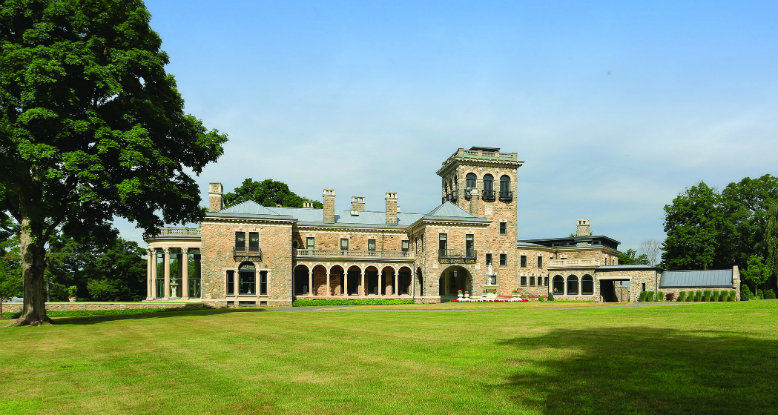
Stronghold at 450 Claremont Road in Bernardsville. Photo courtesy of David Gruol
Architect George B. Post (who designed the New York Stock Exchange building) purchased 104 acres on Bernardsville Mountain in 1871 with visions of replicating the rolling, self-sufficient estates of English lords. Wealthy banker James Coleman Drayton bought a portion from Post, and hired him to build a stone villa featuring a four-story tower. By 1899, Prudential Insurance cofounder John Fairfield Dryden purchased the estate and added a classical semicircular terrace (now called the Solarium) with Corinthian columns and a staircase flanked by rhino statues. Dryden dubbed his magnificent home Stronghold. The Drydens owned the estate until 1940, when Elizabeth Gill moved her private all-girls boarding school into the mansion. In 1972, the Gill School merged with St. Bernard’s School of Gladstone, creating the Gill St. Bernard’s School. The school consolidated in 1995 and sold the property to new owners, who began restoring the exterior. New chimneys were installed and a zinc roof was imported from France.
However, the ambitious new owners never finished the interior, leaving a gutted granite-and-concrete shell with no wiring or plumbing. Stronghold sat vacant until 2005, when entrepreneur and fashion designer Marc Eckō, a Lakewood native, purchased it for $7.5 million. Eckō’s renovation was a massive “labor of love,” says Coldwell Banker realtor Vincenza Montrone. The restored seven-bedroom mansion is now on the market for $15 million. Because of modern height restrictions (ceilings are limited to 35 feet), you can no longer build a home like Stronghold, says Montrone, adding, “It’s really one of a kind.”
Breidenhart Castle
Moorestown
Lutheran Crossings Enhanced Living
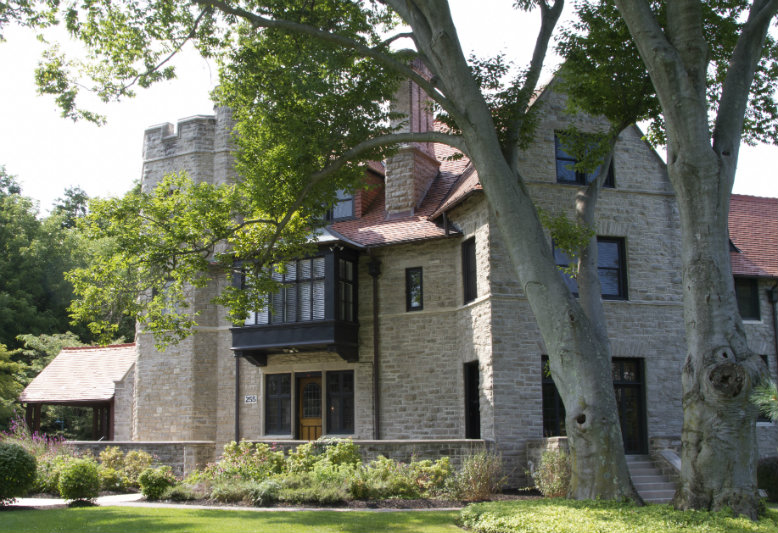
Breidenhart Castle at 255 East Main Street in Moorestown. Photo courtesy of Trish Proto
A number of New Jersey’s most successful inventors chose to spend their wealth constructing castles. One was Samuel Leeds Allen. Born a Quaker in 1841, he was a prolific tinkerer who fashioned a variety of farming implements at Ivystone, his family’s Cinnaminson Township farm. However, these inventions were only in demand during warm seasons. In 1889, Allen came up with the off-season idea of a steerable sled. He tested early models on the hilly grounds of his Quaker alma mater, Westtown Boarding School. The relatively inexpensive toy, named the Flexible Flyer, was a huge hit. Allen purchased a dozen acres in Moorestown, including Stokes Hill—a popular sledding destination to this day.
Having secured his fortune, Allen hired architect Walter Smedley to build a Tudor Gothic-style castle for the Allen family in 1894. Names like New Ivystone and Longmeadow were considered for the hilly estate, but it was ultimately named Breidenhart, an ode to the lost family name of Allen’s great-grandmother. (The Old German family name, Breitenherd, means “broad hearthstone” or “hospitality.”) Allen died just before WWI ended in 1918.
In 1920, the castle passed to Eldridge R. Johnson, cofounder of the Victor Talking Machine Company in Camden. Johnson, who had trained as a machinist, invented the Victrola, a wind-up phonograph that helped transform home entertainment.
Eventually, Johnson’s widow sold the expanded Breidenhart to the Lutheran Home of New Jersey. It was added to the National Register of Historic Places in 1978 and awarded a grant by the Garden State Historic Trust Fund in 2004 to aid in renovations.
Breidenhart would not be a castle without a maze of passageways and fake wall panels. One camouflages a restroom; another panel with a tiny knob conceals an old house phone. The castle is used for meetings and events, including a 2006 fundraiser where the various rooms were decked out with vintage Flexible Flyer memorabilia.
Merriewold Castle
Highland Park
Commercial office space
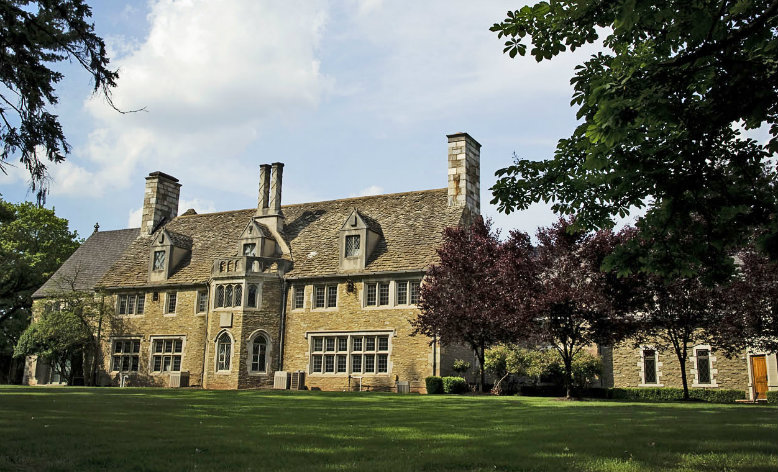
Merriewold Castle at 433 River Road in Highland Park. Photo courtesy of Natalie Licini
An honor roll of New Jersey castles would be incomplete without the strange, cursed estate built by the Johnson & Johnson bankroll. In 1924, J. Seward Johnson, the second son of J&J cofounder Robert Wood Johnson, married Ruth Dill, sister of Diana Dill (an actress and mother of actor Michael Douglas). As a wedding present for Ruth, Seward built a castle on a magnificent plot above the Raritan River in Highland Park. The idyllic setting was named Merriewold, meaning “merry wilderness.”
The home, boasting 150 leaded-glass windows, 11 fireplaces, arched passageways, ramparts and two turrets, was finished in 1926. Spiral staircases are hidden in the walls and a swinging bookshelf conceals a liquor cabinet—a convenient feature for a Prohibition-era home. Unusual details like plaster reliefs of sea creatures, including whales and lobsters, decorate the exterior.
Diana, the couple’s third daughter, was born in January 1932, just before the infamous kidnapping of Charles Lindbergh’s 20-month-old son in nearby Hopewell. A few weeks after, an intruder (who had robbed the Johnson’s at Merriewold once before) returned to the castle with an inspired plan. Sneaking past security guards, he climbed a ladder to the second-story nursery where young Diana slept. Though the criminal was chased away and caught, paranoid Seward added bars on the windows and barbed wire to the grounds.
Ruth divorced Seward in 1937 due to “extreme indifference” and was granted both Merriewold and custody of the children. She remarried in 1940 and moved into the modest carriage house; she lived there with her second husband until her death in 1987. (This only scratches the surface of Seward’s time at Merriewold; more outlandish exploits can be found in Crazy Rich: Power, Scandal, and Tragedy Inside the Johnson & Johnson Dynasty by Jerry Oppenheimer.)
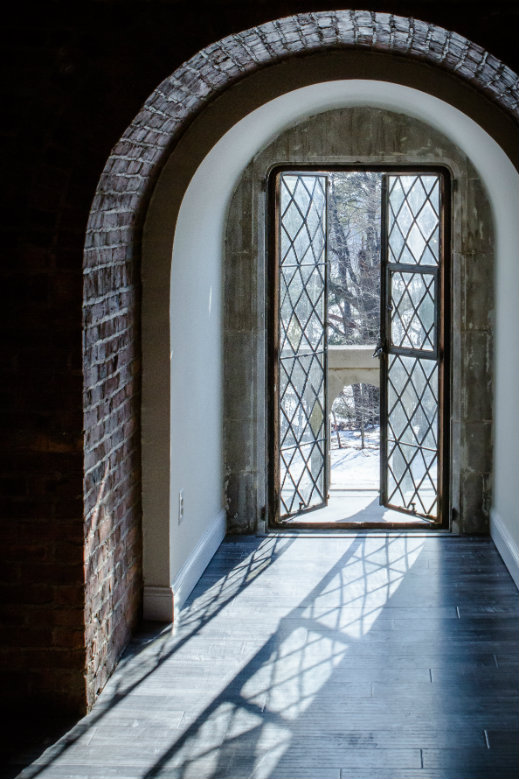
Inside the Je Revele photography studio on the third floor of Merriewold. Photo courtesy of Natalie Licini
The next owners were industrial engineer Charles Farmer and his artistic wife, Barbara. Yet again, the castle’s residents proved to be doomed: Over the years, the Farmers grew to despise one another. Charles accused Barbara of having an affair with art-deco sculptor Waylande Gregory. He claimed the two were building an occult center for practicing black magic in Massachusetts; in reality, it was to be an artist colony called the Berkshire Cultural Center. Charles secured a court order restraining Barbara from entering the home by August 1963. On September 18, Barbara made a pre-arranged visit to the home in the company of her attorney to collect her belongings. Charles confronted the pair in the master bedroom and shot Barbara three times with a .32 caliber pistol, then turned the gun on himself. Charles lived through his attempted murder-suicide; his estranged wife was not so lucky. After his recovery, the Superior Court deemed Charles unfit for trial and sent him to a state hospital for the criminally insane. (The ruins of the bizarre, half-finished artist colony can be found off the Keystone Arches Trail along the Westfield River in Middlefield, Massachusetts.)
In 1968, builder Nathan Kaplan purchased Merriewold and converted it to commercial office space, including the headquarters of his construction firm. Current tenants include Je Revele , a fine-art photography studio, which occupies the whimsical third-floor, where exposed brick and leaded windows serve as the backdrop for boudoir portraits.
Today, the wooded Rutgers Ecological Preserve surrounds Merriewold. The castle courtyard is home to a Seward Johnson Jr. sculpture titled “On Top of the News,” placed by the artist’s Sculpture Foundation. Perhaps the life-size man reading a newspaper is an ode to the headlines the castle once generated, from “A Second Kidnapping Sensation In Many Ways Paralleling The Lindbergh Case, Startled New Jersey Today,” in 1932 to “Industrial Designer Shoots Wife in 25-Room River Road Mansion” in 1963. The Kaplans have yet to inspire such tabloid fare.




New Jersey does have some beautiful things to offer off the beaten thoroughfares of the Garden State Parkway and the New Jersey Turnpike. Don’t forget Lambert Castle on Garrett Mountain in Paterson.